One end of a U-tube containing mercury is connected to a suction pump and the other end to atmosphere. A small pressure difference is maintained between the two columns. Show that, when the suction pump is removed, the column of mercury in the U-tube executes simple harmonic motion.
Now here the liquid on side of U-tube rises whereas on the other side of the U-tube containing mercury it has depressed by same amount due to the suction pump, the weight of the excess mercury will exert force in downward direction in downward direction to restore to original equilibrium position, let the area of cross section be A and ride in height of mercury be X
The situation has been shown in the figure

so total excess height of mercury on side of tube is 2x
now we know
Volume = Area × length
Here surface area of cross section of tube is A, excess height of mercury on side of tube is 2x so the excess volume of mercury on one side of the U-Tube is
V = 2xA
Now we know mass is given as
m = V × ρ
where m is the mass of the body, V is its volume and ρ is the density
so excess mass of mercury on side of tube is
m = 2Axρ
where A is the area of cross section of cork, ρ is density of mercury
we know weight of a body is given as
W = mg
Here m is the mass of the body and g is acceleration due to gravity, so weight of the excess mercury on one side of tube is
W = 2Axρg
Now this excess weight of mercury one side will exert force and tend to bring mercury in the tube to its original position hence the mercury in tube will start oscillating and height will decrease and increase periodically
now total mass of the mercury in U –Tube will be
M = Volume × Density
Let the total length of U – Tube be l and area of cross section is A we know
Volume = Area × length
so total Volume of liquid is
Vm = Al
So total mass of mercury is
M = Vmρ = Alρ
Where ρ is the density of mercury
We know force on a Body is
F = ma
Where m is the mass of Body and a is the acceleration of the Body, so acceleration of the body can be written as
a = F/m
here mass of the total mercury in the tube is
M = Alρ
where A is the area of cross section of cork, ρ is its density and l is the length of U - tube
so net acceleration of mercury in U-Tube is
a = -W/M
(negative sign because acceleration of mercury at each point inside tube is opposite to the direction of displacement)
i.e. a = -(2Axρg)/Alρ
= -(2g/l)x
we know condition for simple harmonic motion is that acceleration is proportional to distance from mean position and is directed toward mean position
and we have relation between acceleration and displacement as
a = -ω2x
where a is the acceleration of Body undergoing Simple Harmonic Motion with angular frequency ω, x is displacement from equilibrium or mean position
here in this case the acceleration of mercury is always directed towards mean position and also acceleration is given as
a = -(2g/l)x
here acceleration due to gravity g, length of tube l are constant so we can say acceleration is proportional to displacement from mean position, i.e. mercury in tube is undergoing simple harmonic motion, so comparing with the equation for acceleration of simple harmonic motion we get
ω2 = 2g/l
i.e. the angular frequency is

We know relation between time period T and angular frequency ω T = 2π/ω
So we have the time period of the oscillation as

So time period of the Simple harmonic motion mercury in tube is
